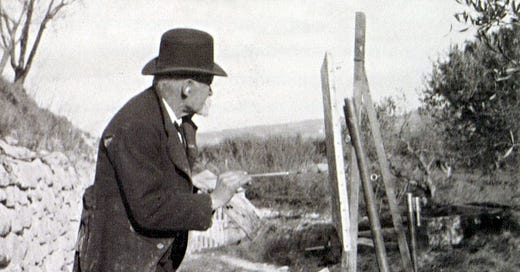Cézanne on the artistic temperament
“With only a little temperament, one can be a lot of painter.”
Hi everyone! I was so focused on my book project these last two weeks that I didn’t have time to write a new newsletter issue for you all—my apologies. Instead, here’s one from the archive, originally published in June 2021.
For my book, I’m currently trying to finalize a section on Paul Cézanne’s financial life (he got an allowance from his father for years, but this arrangement was not without its stresses!), hence my decision to republish this piece on the legendary Post-Impressionist. But also: I continue to be fascinated by the role of temperament in life and art, and these Cézanne quotes dovetail with some of the stuff I’ve been thinking about lately—I’m hoping they’ll resonate with some of you as well.
Before we get to it, I wanted to remind everyone that I’m continuing to host my Worm Zoom sessions every weekday morning. This is a really useful tool for greater accountability and camaraderie for writers, artists, or anyone working on a long-term creative project. But don’t take my word for it! Two of the current participants kindly volunteered the following testimonials:
I’ve been struggling to bring a challenging project to its conclusion, and Worm Zoom has given me the magical combination of discipline and encouragement. Discipline, because it is a set time every day to put everything else aside and focus on my project, and encouragement, because I am not struggling alone. In short, Worm Zoom has been life-changingly good!
Don’t sleep on Worm Zoom! It’s a lovely group of folks, hosted by Mason, who write together every weekday. There is no pressure to speak or turn your camera on. Just show up, do your work, and feed the vibes. 🌱🪱✨ I have accomplished so much!
If you’d like to join, here’s how it works:
Sessions take place every weekday morning from 6–8am Pacific / 9–11am Eastern time.
At the beginning of each session, I say a few words of welcome. Then we all turn our cameras off and work “separately together” for two hours. (Note: You don’t have to turn your camera on at all.)
Join at any point in the two hours and stay for as long as it’s useful and your schedule allows. If you like, use the tracking spreadsheet to log your sessions.
At the end of each session, there will be an opportunity for participants to give a quick progress report, announce any project milestones, or share a brief piece of inspiration or advice.
In addition, on the 15th of each month we will have a Worm Salon—an extended get-to-know-each-other chat/hangout immediately following the Zoom session. This is our opportunity to talk at greater length about what we’re all working on and what challenges we’re facing.
Worm Zoom is open to all paid newsletter subscribers. Every day, I post the link to next session right here. So please bookmark this page!
OK, on to Cézanne:
Originally published June 7, 2021
Paul Cézanne (1839–1906)
The opening yesterday of the exhibition Cézanne Drawing at MoMA seemed like a good excuse to look into the legendary French artist’s creative process. So, last week, I spent some time with Alex Danchev’s 2012 biography, Cézanne: A Life, to see what I could find out. In particular, I was looking for information on Cézanne’s concept of réalisation, which I first read about in a 1988 interview with the English painter Bridget Riley (found in this book). Talking about her own process, Riley said:
In making the paintings I proceed step by step, and test the ground before I make a move. . . . In a daydream way I have a sort of hunger about what I am going to do, or rather about the sensation I want the painting to precipitate or convey. It’s actually bringing this sensation into existence that is the difficulty; what Cézanne called ‘realization’.
In his biography, Danchev never really defines réalisation, but you get a strong sense of it nonetheless. For Cézanne, it didn’t just mean that a given work “succeeded,” exactly; it was more elusive than that. It involved a union of subject matter and the artist’s unique perception of that subject matter. As Riley said, it was about bringing a specific sensation into existence for the viewer. And, for Cézanne, it was tied up with the idea of temperament. Danchev writes:




